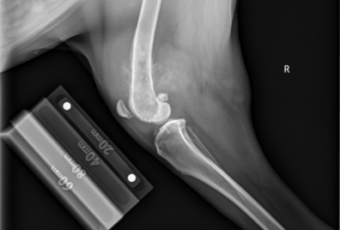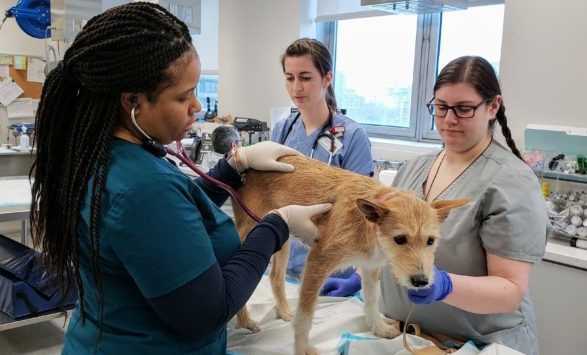Osteosarcoma in Pets
Background
Cancer is not one disease, but hundreds. Cancer can be grouped into three main categories:
- Carcinomas – carcinomas are formed by epithelial cells, which are the cells that cover the inside and outside surfaces of the body. Tumors of the anal gland and mammary gland are common carcinomas in dogs and cats.
- Hematopoetic tumors – blood cancer, or hematopoetic tumors, include leukemia and lymphoma.
- Sarcomas – sarcomas are tumors formed by cells from bone and soft tissues, including muscle, fat, blood vessels, lymph vessels, and fibrous tissue (such as tendons and ligaments). Examples of sarcomas in dogs include soft tissue sarcoma, hemangiosarcoma, and osteosarcoma.
Osteosarcoma is the most common bone tumor in dogs, accounting for 85% of all canine skeletal tumors. While osteosarcoma is also the most common bone tumor in cats, primary bone tumors are relatively uncommon in cats to begin with. Osteosarcoma is also far less aggressive in cats than it is in dogs.
Osteosarcoma typically develops on the limbs (the forelimbs more often than the hindlimbs), but can also occur on the skull, rib cage, and spine. A rare form of osteosarcoma occurs outside the skeleton in the muscles, liver, or spleen. Osteosarcoma is a particularly aggressive tumor in dogs, with 75-90% of patients eventually having the tumor cells metastasize (spread) to other areas, particularly the lungs and other bones. In cats with osteosarcoma, around 40% will metastasize.
Risk Factors
Osteosarcoma typically develops in middle-aged large or giant breed dogs (body weight above 40kg or 90lbs). Certain breeds are genetically predisposed to the disease, including:
- Great Danes
- Golden retrievers
- Labrador retrievers
- Rottweilers
- Saint Bernards
- Scottish deerhounds
There does not appear to be any correlation between body weight and the development of osteosarcoma in cats. While large breed dogs are more prone to this disease, any dog or cat can develop this type of bone tumor.
Currently, veterinary researchers are investigating links between age at neutering and osteosarcoma. Since this is an active area of research, check with your veterinarian who will help you weigh the risks and benefits for when to spay/neuter your pet.
Signs
The following signs vary depending on which bone is affected, but may include:
- Limping/lameness
- Swelling or bump on the affected bone
- Fracture (with no known traumatic injury)
If the tumor has metastasized, signs may also include:
- Breathing difficulties
- Weakness
- Swelling of all four limbs

Diagnosis
Your veterinarian will take an x-ray of the boney swelling and perform a biopsy to identify the type of tumor present. Osteosarcoma causes the bone to have a mottled or moth-eaten appearance on the x-ray. Chest x-rays or CT scans are also recommended in order to check if the tumor has metastasized to the lungs and other areas of the body.
Treatment
If your pet is diagnosed with osteosarcoma, your veterinarian may refer you to a board-certified cancer specialist called an oncologist who will recommend a treatment plan. Treatment depends on the location of the primary bone tumor, but most cases typically include surgery (limb amputation or limb-sparing surgery), chemotherapy, and radiation therapy (a palliative method of treatment to reduce pain).
The most common treatment for osteosarcoma is amputation of the affected limb in order to minimize the risk of the cancer spreading. Amputation not only helps to control the tumor locally, but it provides pain relief for the patient. While pet families may worry about their pet’s loss of mobility or the cost of surgery, pets have very low complication rates after the procedure, and it can be the most cost-effective treatment available. As a matter of fact, a majority of dogs can walk unassisted 12 to 24 hours after amputation.
Limb-sparing surgery, where the portion of the bone containing the tumor is removed and donor bone graft is implanted, may be an option for certain patients but this is a more complex surgery. Surgery is also the most common treatment for tumors on the axial skeleton (skull, ribs, or spine), but the specific procedure will depend on the size and location of the tumor.
The best outcome for dogs with osteosarcoma includes treatment with both surgery and chemotherapy. The goal of chemotherapy is to delay the spread of osteosarcoma throughout the body. The most common chemotherapy medications used are carboplatin and doxorubicin. Optimal chemotherapy for feline osteosarcoma has yet to be defined.
In dogs with other disorders that preclude amputation as a treatment for osteosarcoma, radiation therapy can control the pain associated with the tumor and improve the dog’s mobility.
Palliative care for osteosarcoma focuses on pain relief and improving the patient’s quality of life. Options include pain relief medications (such as non-steroidal anti-inflammatory drugs) and bisphosphonate which slow bone loss caused by the tumor.
Prevention
As osteosarcoma is largely a genetic condition with strong breed predilections, you cannot predict nor prevent the development of this disease. This is why it’s so important to bring your pet to the veterinarian should you notice any changes in your pet, such as swelling at a certain body part or the development of limping.
If you don’t live close enough to the Schwarzman Animal Medical Center to come to our Cancer Institute, you can find the veterinary oncologist nearest to you here: https://vetspecialists.com/
Make an Appointment































